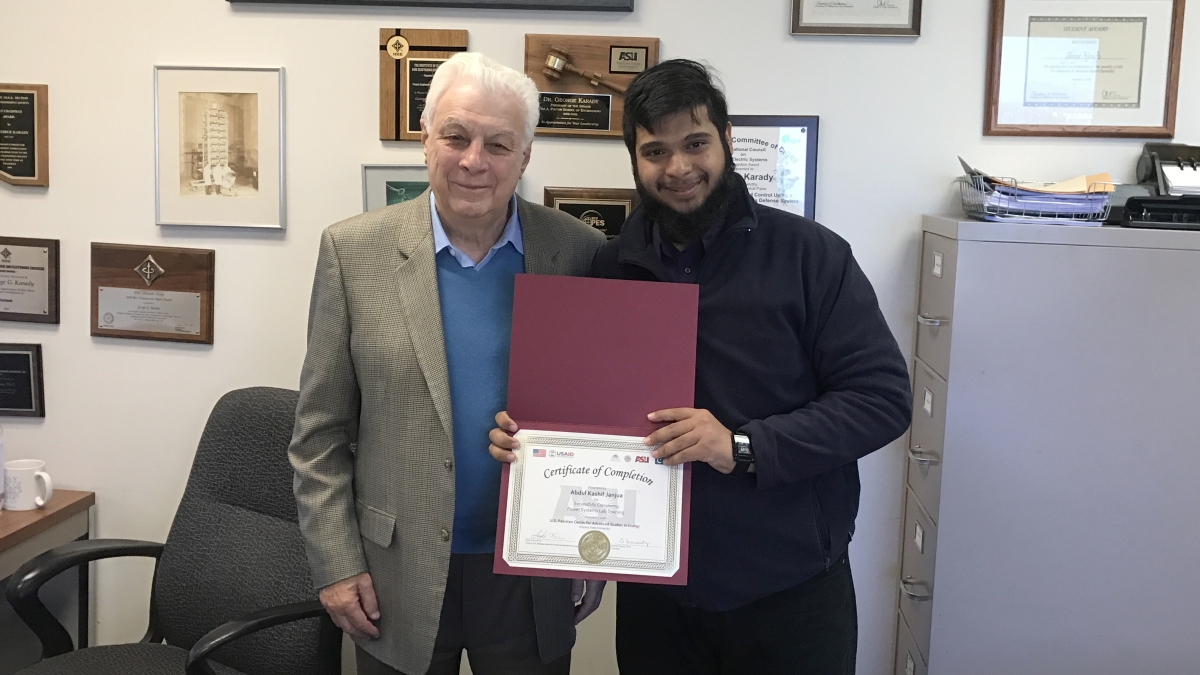ASU scholar collaborates on solar research, benefits Arizona and Pakistan
The U.S.-Pakistan Centers for Advanced Studies in Energy is making gains in research

Above: Abdul Kashif Janjua, exchange scholar from the U.S.-Pakistan Centers for Advanced Studies in Energy, known as USPCAS-E, with his certificate of completion from the Power System’s Lab in fall 2016. Photo courtesy of Abdul Kashif Janjua
It can be tricky balancing affordable electricity bills for customers and profits for utility companies, but the happy medium might lie in solar energy storage.
Abdul Kashif Janjua, a fall 2016 exchange scholar from the U.S.-Pakistan Centers for Advanced Studies in Energy at Arizona State University, analyzed data and patterns to find an equilibrium for both sides of the equation.
Kashif collaborated on a research paper titled, “Customer Benefit Optimization for Residential PV with Energy Storage System” under the tutelage of George Karady, a professor of electrical engineering at ASU's Ira A. Fulton Schools of Engineering and an Institute of Electrical and Electronics Engineers Fellow.
Different combinations of solar panels and different sized batteries were tested in concert to find the right combination. The research accounted for variables like load, temperature and battery discharge rates to derive the best result for both customers and utilities.
The paper was presented at the Institute of Electrical and Electronics Engineers Power Engineering Society’s general meeting in Chicago in July. Presenting the paper at the Power Engineering Society was significant because the organization acts as one of the largest forums for sharing the latest in technological developments in the electric power industry, for developing standards that guide the development and construction of equipment and systems, and for public and industry education.
Dr. George Karady representing the U.S.-Pakistan Centers for Advanced Energy and ASU, surveys posters at the IEEE PES 2017 General Meeting . Photo credit: IEEE PES
Kashif compared the climates of Arizona and Pakistan saying that, “they are quite similar so photovoltaic systems are feasible in both areas.”
The research can be used to optimize variables like the size of the photovoltaic system and various charging strategies, “[with] the only difference being the tariffs which can be programmed into the developed algorithm,” Kashif explained. This leaves a door open for computers to eventually determine the right balance, possibly even using artificial intelligence in the future.
Over the next five years, Arizona is expected to install 3,380 megawatts worth of solar electric capacity, ranking it fourth in that time period in the United States. Meanwhile, Pakistan has been suffering from rolling blackouts from six to 16 hours a day. Both areas have much to teach each other about renewable energy.
The collaboration process with Pavan Etha and Anil Chelladurai, electrical engineering graduate students at ASU, as well as the mentorship he received from his time at ASU has been an invaluable asset to his education. Of Karady he stated that, “he was [the] most supportive, helpful and encouraging professor.”
He went on to say that Karady’s “knowledge and experience with electrical systems can be rarely found even in the best universities of the world and he was not reluctant to share each of his experiences related to our field."
This type of collaboration between the United States and Pakistan is a hallmark of USPCAS-E because it allows for progress in energy research for the countries’ mutual benefit.
Kashif’s time at ASU rolls into the eventual completion of his master’s degree at Pakistan’s National University of Sciences and Technology in the field of energy systems engineering. Plans are in the works for him to pursue a doctorate and then potentially apply his research in the commercial sector. In the meantime, he is in the process of publishing another research paper along similar lines in Pakistan.
The USPCAS-E project has now reached a point in its evolution where the return from this type of investment in education is now resulting in exciting research findings. Outcomes from USPCAS-E’s scholars are timely as they fall at the heels of Pakistan celebrating its 70th anniversary of independence and its continued collaboration and development with the United States.
More Science and technology

Advanced packaging the next big thing in semiconductors — and no, we're not talking about boxes
Microchips are hot. The tiny bits of silicon are integral to 21st-century life because they power the smartphones we rely on,…

Securing the wireless spectrum
The number of devices using wireless communications networks for telephone calls, texting, data and more has grown from 336…

New interactive game educates children on heat safety
Ask A Biologist, a long-running K–12 educational outreach effort by the School of Life Sciences at Arizona State University, has…
